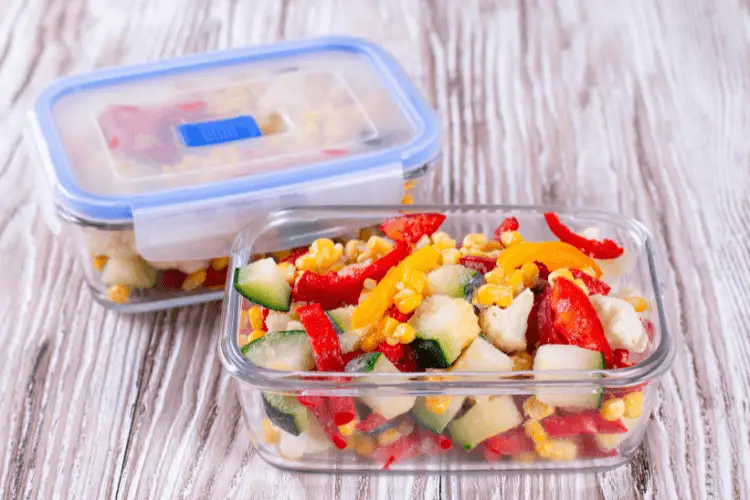Wondering if you can microwave Ziploc Tupperware? It would be super convenient to heat your food in Ziploc bags and containers.
For instance, when using a Ziploc bag, it’ll save you a lot of post-cooking cleanup.
But since Ziploc products are made of plastics, are they microwavable? Can you microwave Ziploc Tupperware?
Yes, Ziploc containers and bags are microwave safe. They are specially made for use in the microwave and usually come with a “microwave-safe” label.
All Ziploc products meet FDA (Food and Drug Administration) safety requirements for reheating and defrosting food in the microwave.
An important point to take home is that although microwavable, Ziploc products shouldn’t stay in the microwave for too long. To avoid overheating, you should also reheat them only on medium to low power settings.
What is Ziploc Tupperware Made of?

Ziploc containers are made of low-density polypropylene and linear low-density polypropylene. Polypropylene is one of the most common forms of microwave-safe plastic with a high melting point.
On the other hand, Ziploc bags are made from low-density polyethylene (LDPE) and high-density polyethylene (HDPE). The bags have a melting point of 195 degrees F or 90.5 degrees C.
Ziploc Tupperware can withstand microwave defrosting and reheating temperatures but not baking or cooking temperatures.
Therefore, although these products might come with a microwave-safe label, it’s wise for you to go through the manufacturer’s instructions of use.
Limitations on Microwaveable Ziploc Tupperware

Although microwaveable Ziploc Tupperware containers meet the FDA requirements, this isn’t the whole story. There are a few limitations on how you can use them.
Ziploc bags and containers can only handle reheating and defrosting temperatures. You should never use them for cooking.
Cooking requires high temperatures and the melting point of Ziploc products is below the temperatures required for cooking.
Should you cook in a Ziploc bag or container, expect them to melt during the process. You don’t want this to happen at all. The process leads to the leaching of toxic chemicals into your food.
Even a Ziploc bag or container labeled as microwave-safe should never be used for cooking.
BPA-Free and Dioxin-Free?
Yes, Ziploc products are FDA certified as BPA-free and dioxin-free. In fact, they are even designed to be recyclable.
Are they made from recycled materials? No. If you want to recycle a Ziploc bag or container, you can only reuse them for other purposes once they get compromised.
For instance, if your Ziploc container gets a crack, you can use it for storage.
How Safe is it to Microwave Ziploc Tupperware?
It’s very safe to microwave Ziploc Tupperware if you follow the manufacturer’s directions.
For Ziploc containers, ensure that you only microwave them on medium to low heat settings with durations of I-minute increments. Use the same power settings for Ziploc settings but with increments of 30 seconds.
You also need to take precautions like venting the bag to prevent pressure from building inside.
Can you Steam Veggies in Ziploc Tupperware?
You can’t.
Steaming ensures a higher heat transfer compared to boiling water. This can lead to the melting of the film making the Ziploc bag or container.
Should the bag melt, it can leach chemicals into your food, which is dangerous to your health.
How Long Can You Microwave Ziploc Tupperware?
When defrosting or reheating, don’t overheat since the bag might melt. Follow the 30-increment rule to avoid melting.
You also need to set the power on low to medium to control the heat so that it doesn’t go beyond the softening point of the Ziploc bag.
In addition, inspect the state of your Ziploc bag or container every 30 seconds to ensure that it doesn’t overheat.
Things to Know About Microwave-Safe Ziploc Tupperware
Ziploc Tupperware is ideal for reheating and defrosting food in the microwave. They are made from polyethylene, a compound free of BPA and dioxin.
Ziploc bags and containers are FDA approved for safe use in the microwave, but you need to accurately follow the manufacturer’s instructions.
Always remember that Ziploc bags and containers come with risks that can affect your food if improperly used.
To avoid the risks:
- Only use Ziploc bags and containers for reheating and defrosting
- Be on the lookout for the microwave-safe label usually indicated on the product. Don’t put the container or bag in the microwave if it doesn’t have the label.
- Always place the bag or container on a microwave-safe plate before placing it in the microwave.
- Avoid microwaving your Ziploc bag for too long, as this can lead to overheating.
- Ensure that the Ziploc bag or container is vented to avoid steam and pressure buildup, which can lead to rupturing.
- Avoid reheating food with high sugar and fat content.
- Never use a Ziploc bag or container for cooking or reheating food.
After taking all the considerations listed above, you should be able to use a Ziploc bag or container in the microwave safely at all times.
However, if you are still in doubt of Ziploc Tupperware safety in the microwave, consider using microwave-safe containers made of glass or ceramics.
Conclusion
Can you microwave Ziploc Tupperware? The answer is yes, you can. All Ziploc Tupperware is microwavable as long as they come with a microwave-safe label.
However, you can use the products for reheating and defrosting purposes only. If using a Ziploc bag, microwave it on low to medium settings at 30 seconds increments only.
And although Ziploc containers have a higher melting point, they should also be microwaved on low to medium power settings at 1-minute increments.
When microwaving Ziploc Tupperware, place it on a microwave-safe plate or dish. Handle the bag with care and keep checking on it just to ensure that it doesn’t overheat.

